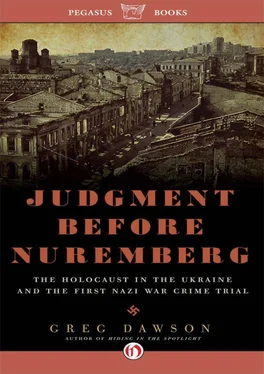Himmler’s order to find a more humane, hands-off method of execution led to an experiment with the help of a chemist from an institute of technology. Some thirty mental patients were locked in a sealed room and carbon monoxide was pumped in from a car exhaust. Five minutes of that seemed to have no effect on the trapped patients. The chemist concluded that the car exhaust was not sufficiently lethal, so a second hose was connected to a truck. That did the trick—in five minutes the patients were unconscious. The successful test was reported to Berlin, and development began on a mobile gas chamber.
The technical department of the Reich Security Head Office, under the leadership of Obersturmbanfuhrer Walter Rauff, produced two rolling death houses: a Saurer truck that could accommodate fifty to sixty people, and a Diamond, made to hold twenty-five to thirty passengers. They resembled ordinary delivery trucks and had lights to illuminate the interior. The first experiment of the new vehicle was in Germany using thirty Soviet prisoners of war. It was a huge success. After a thirty-minute drive, all the prisoners were dead. Cause of death was carbon monoxide poisoning, the effects of which were vividly described by Soviet medical experts who examined the bodies of gas wagon victims exhumed in Ukraine: “The skin, skeletal muscles and mucous membranes of lips, stomach, intestines, pericardium, and peritoneum were either a pale pink, or bright cherry color, also noted in some cases in sections of internal organs such as the kidneys, lungs, and heart.”
By December 1941 (or a month or two earlier—accounts differ), the gas vans were rolling in Ukraine and other occupied areas. They were also used in the Chelmno extermination camp. However, euphoria over the successful road test in Germany soon faded as reports filtered in from the field where the vans were proving to be more trouble than they were worth. There were equipment problems, weather problems, operator errors.
“The uneven surfaces and road conditions are causing the nails to come loose from the seals and joints,” Dr. Becker reported after an inspection trip to Ukraine. “The brakes of the Saurer van which I took from Taganrog to Simferopol were damaged on the way. When I reached Stalino and Gorlovka a few days later, the drivers of the vans there complained of the same trouble. The gassing is generally not carried out correctly. In order to get the Aktion finished as quickly as possible, the driver presses down on the accelerator as far as it will go. As a result, the persons to be executed die of suffocation and do not doze off as was planned.”
Dr. Becker noted that despite his best efforts at masquerade, no one was fooled about the true mission of the wagons. “I have had the vans disguised as house trailers, by having a single window shutter fixed to each side of the small vans, and on the large vans two shutters, such as one sees on farmhouses in the country. The vans had become so well known that not only the authorities but the civilian population referred to them as ‘Death Vans.’ In my opinion the vans cannot be kept secret for any length of time even if they are camouflaged.”
But even worse, and most ironically, the gas vans were producing a more grotesque horror show than the shootings they were designed to replace. A citizen forced by Germans to help unload the vans gave this account:
“A dark gray vehicle, looking like an ambulance, arrived in the clearing a number of times. When the back door was opened, human bodies fell out—men, women, and children. The bodies were joined together, as if linked by a convulsive embrace in distorted postures, with faces bitten away. I saw one man’s teeth sunk in another’s jaw. Some had their noses bitten off, some their fingers. Many were holding their hands in a convulsive grip—they must have been members of the same family. These corpses we were told to separate by force. When it could not be done, we were ordered to hack them, cut off hands, legs, and other parts.”
Paul Blobel, leader of a Sonderkommando unit and ruthless orchestrator of the Babi Yar massacre, was driven to drink by the gas wagon horrors. His driver describes taking Blobel to an unloading site for the wagons. “Jews who were still alive unloaded the bodies that had not fallen out when the doors were opened. The bodies were covered with vomit and excrement. It was a terrible sight. Blobel looked, then looked away, and we drove off. On such occasions Blobel always drank schnapps, sometimes even in the car.”
The gaswagens became the Edsel of the Nazi motor pool. The leader of Einsatzgruppe B said thanks, but no thanks, sending his allotment on to Einsatzgruppen C and D. Though they never became the high-volume killing machines Himmler hoped for, the gaswagens were used to murder thousands of Jews, mostly women and children. In Crimea, the non-Jewish nurses in a convalescent home betrayed fifty-two children who were then killed in gaswagens . The identical scenario occurred at Minsk Children’s Home No. 1 where thirty Jewish children were betrayed by the manager and driven away in a gas wagon—out of sight and out of mind.
The primary responsibility of Bulanov, the collaborator who stood trial with three Nazis in Kharkov, was driving a gas wagon. Ukrainians called it dushohubka —the destroyer of the soul. Bulanov said the wagon he drove was “a huge two-axled truck of approximately five to seven tons capacity. It was painted gray and had a six-cylinder engine. The body of this machine had folding doors which closed hermetically. It was evidently made airtight by means of the rubber lining of the door.” Bulanov described a typical pickup, this one from a hospital in Kharkov.
“Gestapo men began to lead out patients dressed only in their underwear, and load them into the trucks. After loading, I drove the truck to the shooting site under German escort. The place was approximately four kilometers from the city. When we arrived at the shooting site, screams and sobs of patients who were already being shot filled the air. The Germans shot them in front of the other patients. Some begged for mercy and fell down naked in the cold mud, but the Germans pushed them into the pits and then shot them.”
How fortunate for Himmler, with his tender sensibilities and compassion for both shooters and victims—on display at Minsk—that he was not present at this piteous display.
“Himmler wanted his victims to be killed without bloodshed and his SS men to be just like other workers, which is the fundamental reason he switched the method of killing from Einsatzgruppen executions to gas vans and gas chambers,” [3] Rhodes, Masters of Death , 282.
said Richard Rhodes. As Levin wrote, this switch served the larger purpose of hiding the Nazi crimes by destroying the evidence. “The fear that the world would know what was happening even deep within Russia and the need for swift annihilation led the Nazis to contrive the technical improvements at the gassing camps where the secrecy of mass exterminations could be guarded more easily.” [4] Levin, The Holocaust , 261.
Himmler’s dream of an antiseptic Holocaust in which there was no blood and bones, no screams of wounded women, no corpses covered with vomit and excrement, a Holocaust in which the dead did not pile up at his feet but instead disappeared into the sky as ashes—that Holocaust came to fruition at Auschwitz. Observing an extermination with Zyklon-B at the camp in July 1942, with the wind at the Nazis’ back across Europe, Himmler surely felt fulfilled. That messy, awkward day in Minsk could be forgotten.
“Now he could watch a crowd of people murdered without batting an eye and go on to an evening of Gemutlichkeit with Hoss, the local Gauleiter, and their wives, even allowing himself to smoke a few cigarettes and drink a glass of wine,” Rhodes wrote.
Читать дальше












